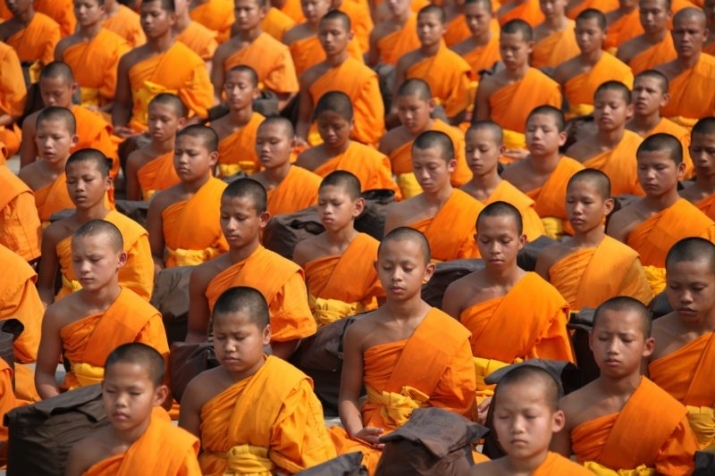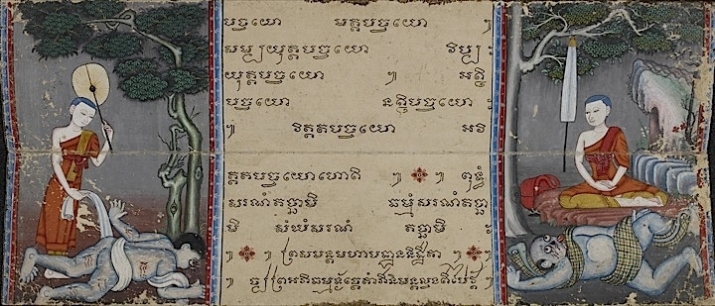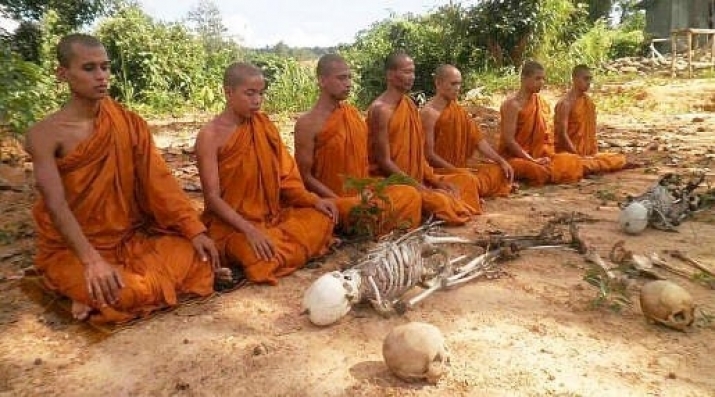NEWS
Meditation on the Morbid in Thailand Offers Insights into Impermanence
 Meditative techniques have been preserved in ancient Buddhist texts and are passed down from teacher to student within the numerous Buddhist traditions. From calmscience.net
Meditative techniques have been preserved in ancient Buddhist texts and are passed down from teacher to student within the numerous Buddhist traditions. From calmscience.netMeditation is a key aspect of the Buddhist practice. Numerous meditative techniques, some very specialized, have been preserved in ancient Buddhist texts and are passed down from teacher to student within the many Buddhist traditions. Some less orthodox meditation practices observed by monastics in Thailand might appear extreme or alarming to those of us familiar with the more tranquil approach of simple mindfulness meditation, yet offer a unique, direct insight into the transitory and impermanent nature of existence.
While it may seem gruesome or macabre, the practice of meditating next to a decaying or desiccated corpse (Pali: asubhakammatthana) remains relatively common in many temples across Thailand and elsewhere in Southeast Asia. Aimed at imparting a deeper understand of impermanence and helping the practitioner to overcome conditioned states of the mind and emotions, monks undergoing this advanced training use naked corpses of the recently deceased as objects for meditation.
Meditators in this practice are directed to focus on the “disgusting” aspects of the cadaver and the impermanence of the flesh, bones, and fluids. The highest state of meditation is reached when both attraction and repulsion cease to exist. This approach is viewed as a powerful way to learn selflessness, says Justin McDaniel, a professor of religious studies at the University of Pennsylvania. “And the more selfless you are, the closer you are to nirvana.” (The New York Times)
 Illustrations of the 19th century monk Phra Malai meditating over corpses. From blogs.bl.uk
Illustrations of the 19th century monk Phra Malai meditating over corpses. From blogs.bl.ukThe family of a child or young adult who has died unexpectedly will sometimes donate the remains to a temple for this purpose, seeking to make merit and gain a positive outcome from the tragedy. The monks see the deceased young people as “representing the best of humanity,” says Professor McDaniel. “They’re innocent — not so selfish and greedy and ambitious. If something so beautiful can decay, why are you so proud and vain? You’re even uglier.” (The New York Times)
At some monasteries, such as Wat Khao Yai in Thailand’s Pichit Province and Wat Hualompong in Bangkok, a donated corpse is suspended on a hook before monastics who have received permission to undertake this meditation, or the meditators might sit in charnel grounds, viewing corpses before, during, and after cremation. Such practices have been depicted in numerous centuries old manuscripts and murals, and related in the biographies of prominent Thai monks such as Luang Phu Man, Than Achan Taeng, and Somdet To.
The purpose of this traditional form of meditation is “simply to hold in your mind, very clearly, that when you look at a [living] person, you’re seeing only the external aspect of that physical person.” says Siripanyo Bhikkhu, a monk from eastern Thailand. “We just sort of live in denial of the fact that we have all these organs and bones and liquids and fluids. We are obsessed with the externals. No one wants to see the internals. But we try to see them in an equal light, neither delighting nor being repelled by the attractive or the unattractive signs of the external or the internal.” (The Washington Times)
 Corpse meditation is aimed at imparting a deeper understand of impermanence and helping the practitioner to overcome conditioned states of the mind and emotions. From dhammawheel.com
Corpse meditation is aimed at imparting a deeper understand of impermanence and helping the practitioner to overcome conditioned states of the mind and emotions. From dhammawheel.com“It is very common with [monastics] to have [corpse meditation] pictures with us, to use them, or just to have in your hut, or have with you when you are eating, or just to look at and to contemplate,” he says. “That’s what monasteries are for: They remind us of the true nature of life, which is this impermanence and transitory nature.” (The Washington Times)
See more
Corpses, Pythons, Sleep Deprivation: Meditation Rituals in Thailand Can Be Intense (The New York Times)
Years of ‘corpse meditation’ now serving monks well (The Washington Times)
Encountering Corpses: Notes on Zombies and the Living Dead in Buddhist Southeast Asia (Kyoto Review of Southeast Asia)
Corpse Meditation: A Buddhist Practice (Seven Ponds)
Morbid meditations in Thai manuscript art (British Library: Asian and African Studies Blog)
Related
Scientists in Nepal Show the Neurological Benefits of Meditation on Buddhist Monks (Buddhistdoor Global)
Research Confirms the Health Benefits of Drum Meditation (Buddhistdoor Global)
Meditation as Sustenance for Death and Dying (Buddhistdoor Global)
Science Meets Mind - Imagining a Revolution, with B. Alan Wallace (Buddhistdoor Global)
Sayadaw Ashin Nanujjotabhivamsa: “Meditation is the cool water that extinguishes the fire of suffering” (Buddhistdoor Global)














